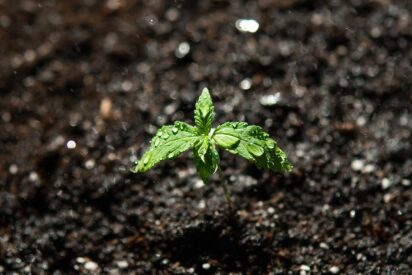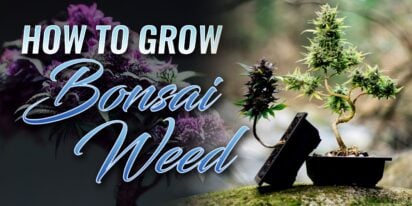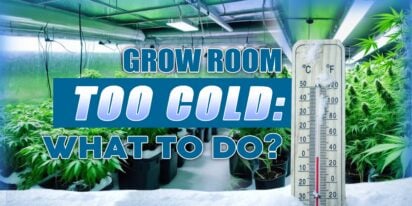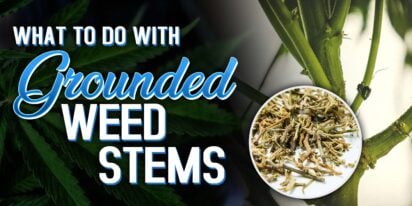
Are You 18 Or Over?
YesOr
No By clicking yes, you certify that you are over 18. By using this website, you agree to our legal disclaimer.605+ Cannabis Strains over 20 Breeders worldwide.
Table of Contents

Cannabis plants are known to be very hardy and resilient plants. You can find these growing in almost all environments, warm, chilly, tropical, or Mediterranean-like climates. This plant is fun to grow too and in fact, you can cultivate this at home. If you wish to grow cannabis plants at home whether, for recreational or medicinal use, you need to understand the different stages of plant growth most especially the cannabis seedling stage.
The seedling phase sets the stage for the growth and development of your plants. When you diligently take care of your seedlings, you will surely grow healthy and productive plants.
The seedling phase starts right after the cannabis seed sprouts. After a few days of being nestled in soft and comfortable soil, the seed will break open from its seams, and out comes the taproot. This main root screws itself downwards until it reaches deep into the soil where it can grow complex roots. When it’s firmly anchored, the seed will raise the husk that contains the two halves.
The two halves of the husk are called cotyledons and are round-shaped leaves. Immediately after the cotyledons sprout from the seed, it will gather enough light to manufacture the plant’s first food. Meanwhile, the feeder roots emerge from the taproot and will continue to move through the soil to gather nutrients and water. These complex roots continue to strengthen its grip to further steady the plant.
Once the seedling is firmly anchored to the ground, the first leaves of the plant or the cotyledons will soon emerge. The two primary leaves have a unique shape and form. These will grow from the middle of the split of the seeds. These round-shaped leaves are known as sucker leaves and these means that the seedlings are ready to grow more leaves.
In between the sucker leaves, three-lobed leaves will form resembling chicken feet. Right after the three-lobed leaves will sprout leaves with five lobes and then after, leaves with seven lobes. The leaves with seven lobes are the most recognizable ones because these look like regular marijuana leaves.
The very first thing you must do as soon as your Cannabis Seeds sprout and start to form new leaves is to protect it. Seedlings are vulnerable to almost anything from birds that may fly by and eat it as a snack to severe heat from the sun. If you sprouted seedlings outdoors in soil, you can improvise some kind of cover.
You may use a plastic bottle as cover for your precious seedlings. Recycle plastic bottles by washing them and cutting these in half. Use the top half to create a transparent dome over the young plant. Aside from the mouth of the bottle, poke more holes on the side of the bottle to allow air to move through. This makeshift dome will also shield plants from the sun and rain. You can use almost all types of plastic bottles as long as these are clean. Make sure to press the bottle deeply in the soil so it won’t be blown away by the wind.
Protect seedlings better by growing these indoors. With indoor growing, you can protect seedlings from the harsh climate, from wild birds and pests. Also, keeping seeds indoors will help keep your plants safe from prying eyes especially if it’s illegal to grow cannabis in your area.
Seedlings need a lot of light to manufacture new plant parts and food to be utilized by the plant as well. If you’re growing your seedlings outdoors, place the potted plants in a shaded area, not directly under the sun as this can dry up the soil quickly, and damage plant parts. If the day becomes too hot, take the plants in a covered area like your patio or porch. Be sensitive to your plants’ needs; if you feel hot then these are likely feeling the same way!
If you are growing your plants indoors, plan out your lighting setup. Provide bright light as much as possible. Use CFL or LED lighting during this phase. You may use high-intensity lamps but it will only be a waste of electricity because your plants are still too small. A CFL lamp would do with 20-hour light and a 4-hour dark schedule would do.
Some growers prefer to keep a 24-hour light schedule to fully sustain the growth of their seedlings but actually, seedlings need dark hours too. Roots grow better during the night time or dark hours. Allowing 4 to 6 hours of darkness would be enough to stimulate natural lighting, the kind that nature provides.
The most common lighting problem at this phase is your plants not getting enough light. When you notice that the seedlings are stretching or growing unusually taller, this means that these are trying to reach up and look for a light source. All plants in the seedling and growing phases do this. Some plants may even crawl to a light source that it senses along the ground.
If you don’t correct this, it may be too late for your young plants. Stretched stems will grow frail and can easily break once more leaves grow from these. Also, it would be difficult to prop stretched stems. Cutting the stretched stems may seem to be the best option. Some growers attest that their plants were able to recover from cutting the stretched parts but there is also a possibility of stressing the seedlings.
Therefore, the key to cannabis plant stretching is to catch the signs early and correct lighting problems early as well.
And as too little light is bad to seedlings, too much can also be worse. Seedlings that are left too long out in direct sunlight can wilt and dry. Remember that the roots of these plants are still underdeveloped and may not be able to take in water as quickly as large and mature plants. The key is to keep the soil moist longer to allow the roots to drink water at its own pace.
If the seedlings are left out in the sun or very hot indoor light for too long, the soil and roots can dry up and this will affect the way your plants take in water. The seedling will soon wilt and die. Therefore, it’s important to maintain a proper distance from the seedling and the light source. A good four or more inches would do well if you are using CFL lamps. A good rule is to place your hand under the lamp. If it’s too hot for you then it’s too hot for your plants.
To save overheating seedlings, take these to a shaded area and water the soil. Let the soil soak in water with excess draining from the hole on the pot. Place a box or an umbrella over the seedlings that are grown directly from the soil. Water the ground until it soaks. Monitor your plants well. These may recover but very wilted seedlings rarely do recover.
After the light, your young plants also need water. Water mobilizes nutrients so these can be easily taken up by the roots. And when it comes to the amount of water to use, it depends on the time of day you’re watering your plants, the type of soil you are using, and the climate.
If you’re using proper soil for cannabis (available in most cannabis growing centers) you only need just the right amount of water because this will be absorbed better and the excess drained from the growing container.
When rainfall is scarce and it’s too hot, you may need to water your plants more than once a day. Of course, all these apply to cannabis seedlings sowed outdoors. For indoor plants, consider watering only when the soil is dry. When you see that the soil is wet or moist then forego watering for a day.
When your plants are outdoors, it would be best to water during the early morning, this is because it still takes a few more hours before it gets very hot. This means that the soil can still absorb more water.
Two common problems with watering are underwatering and overwatering. Both can be very devastating to plants especially during the seedling phase.
Suspect overwatering when your plants look very dewy and fat with water still pooling on the soil surrounding it. If this happens even after a few hours of watering, then your plants are over-watered. If this happens often, or you overlook this then your plants may end up dying.
Underwatering is twice as dangerous to plants as well. This happens if you fail to water your plants for quite some time or the climate is just too hot then your plants. Signs include limp stems and leaves, drooping stems and dry or cracked soil or ground surrounding the plant
To solve overwatering, let the soil dry by increasing heat and by enhancing airflow inside the growing area. Use a small fan (a desk or oscillating fan) will dry up the soil in no time. Plus, the added breeze can help strengthen the stems of plants.
To resolve underwatering, add water immediately to drooping plants. If you’re growing plants in pots, water until you see excess draining from the potholes. Place the pots in a shaded area of your garden or growing area.
Seedlings may not need nutrients. Your young plants have all the nutrients they need to grow healthy from the nutrients contained in the seed cotyledons. However, some growers agree that a little bit of help won’t be a problem.
At this stage, plants need fertilizer with high amounts of nitrogen, a nutrient that helps enhance plant growth and development. With nitrogen, your seedlings will grow healthier and stronger stems and roots, grow more leaves to help with food production and for overall plant health.
Choose fertilizer products meant for the seedling phase (please check the labels!) and follow the instructions on how to apply these to your plant.
Assuming you’re growing cannabis indoors or inside a growing area, you need to maintain this area’s temperature and humidity levels. Seedlings love warmer temperatures around 73 degrees Fahrenheit. But if you feel that this is too hot then you can move the growing lamp further away. You can tell that the seedlings are too warm when you see their leaves curling upwards and have formed a canoe-like shape.
When it comes to the ideal humidity for seedlings, the best would be a higher humidity at around 60 to 70%. You must reduce it gradually as your cannabis plants begin to grow and mature. By the time your plants are in the flowering phase, the humidity levels should be at around 50% or less to avoid mold growth. Follow this schedule:
To improve humidity levels inside your room, use a humidifier/dehumidifier. To increase humidity, use a digital humidifier. This will accurately correct and monitor humidity levels. You may also spray water on the walls and floor of the growing area to improve humidity.
To reduce humidity, open doors, windows or use a fan. A dehumidifier will instantly correct humidity levels and monitor these as well. To accurately measure humidity, use a digital hygrometer- thermometer.
The cannabis seedling stage is short but a very important stage phase of your plants’ development. Handle your plants well and care for it the best way you can during the seedling phase and you will be rewarded immensely during the flowering stage.

In recent years, the discourse surrounding secondhand marijuana smoke has gained significant attention, paralleling the legalization and increas

In the realm of cannabis culture, the practice of "wake and bake" holds a significant place, accompanied by both supporters and skeptics. As exp

Introducing the robust indica strain known as Critical Mass weed, a harmonious fusion of Afghani and Skunk #1 genetics. Delve into its essence,

Fusarium wilt cannabis represents a significant threat to cannabis cultivation, necessitating a comprehensive understanding of its intricacies.

1980s were a time of profound cultural transformation, marked by iconic fashion, music, and movies. Alongside these trends, a unique facet of '8

[ez-toc] In the deep history of cannabis cultivation, there exists a captivating and creative practice that combines the art of cultivation wit

For growers looking to get better yields and healthier cannabis plants, it's important to understand and control the cannabis soil pH levels. pH

[ez-toc] In indoor gardening, maintaining an optimal temperature within your grow tent is crucial for the health and productivity of your plant

[ez-toc] Welcome to the delightful world of cannafudge crafting, where sweetness meets sophistication, and cannabis infusion adds a unique twis

[ez-toc] You’ve finished trimming your weed, but what about those leftover stems? Don’t throw them away! These seemingly useless bits can a

Are You 18 Or Over?
YesOr
No By clicking yes, you certify that you are over 18. By using this website, you agree to our legal disclaimer.